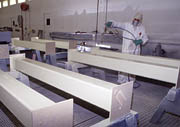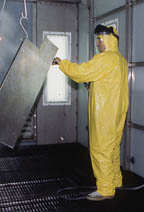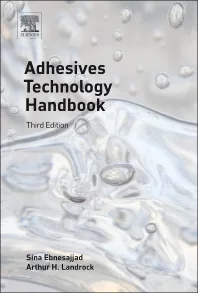Choosing the Right Technology

When is a tried-and-true solventborne system right for the job? When is a waterborne system a better choice? Is it time to consider powder? These are the questions we will attempt to address here.

Tried and true
With all the attention devoted to waterborne and powder coating systems these days, plus the regulatory pressure to reduce VOC and HAP emissions, it would be easy to assume that solventborne coating systems are on the way out. But the $6.5 billion finishing market in North America is still largely dominated by solventborne coating systems.
A new ultra-low-VOC polyester baking enamel utilizing VOC-exempt solvents that emits less than one pound of VOCs is an example of recent advances in solventborne coatings that are helping manufacturers to comply with regulations. With new solventborne technologies under development, it is unlikely that this proven technology is going to disappear from the coatings scene anytime soon.
That's good news for finishers, which have relied on solventborne coatings for many years and have a high comfort level with these systems. Solventborne systems use organic solvent blends as the liquid agent for delivering the resins, pigments, binders, hardeners and other elements comprising the coatings system to the surface of the coating. While film-forming reactions are occurring during curing, solvents evaporate from the surface, leaving behind a hard, durable paint film.
Regulations have restricted the use of many of the solvents previously contained in solventborne coatings because certain solvents classified as HAPs are thought to be toxic and to negatively impact the atmosphere.As a result, coatings manufacturers have had to reformulate many solventborne coatings to meet the new regulations. For example, the commonly used solvents xylol, toluol and MEK are HAPs, while other solvents such as MAK and isopropanol are not HAPs but are high in VOCs. Acetone is a non-HAPs solvent that has been exempted in federal EPA regulations as a VOC contributor, but its fast evaporation rate can limit its use on a broad basis.
Solventborne coatings can be trusted to provide tough, durable finishes that dry quickly, even without baking ovens, to meet production demands. Over the years, sophisticated solventborne systems have set the standard for premium finish quality for both metal and plastic substrates.
Solvent systems encompass fillers, primers, sealers and topcoats. These coatings are often the first choice of metal finishers for military, industrial, agricultural, construction, off-road equipment and consumer products. Frequently, plastics finishers specify solventborne coatings for applications requiring exceptional film durability, long-term performance and superior texturability. These types of manufactured products typically cannot tolerate technologies that require high heat (300°F and above) to cure.
The wide range of solventborne coatings on the market helps to meet the specific application and performance needs of a wide range of manufacturers. Solventborne polyurethane coatings, for example, are a popular technology for high-performance exterior applications such as agriculture and construction equipment. In the metal office furniture and metal building products industries, solventborne polyester coatings are commonly used.
In many ways, solventborne coating systems still remain the benchmark for overall performance, application and appearance characteristics.Today's high-solids solventborne coatings are low in VOCs to meet regulatory requirements. They are formulated without lead or chromates, and applied by a wide range of equipment, including air-assisted airless, airless, HVLP and electrostatics, for great versatility. High-solids, solvent-reduced coatings are often specified because of their low HAPS, low VOCs and improved cost-per-square-foot benefits.
Finishers that coat large surfaces requiring a full gloss range of finishes with little or no orange peel, excellent color and gloss retention, and chemical resistance in exterior exposure, are likely to find solventborne coatings their best bet. These are often high-end agricultural, construction and industrial equipment makers.

When water is better
In high-production facilities facing strict regulatory requirements, or wherever finishers want to reduce fire hazards and costs for solvent cleanup and disposal, waterborne coatings may be a good choice.Waterborne coatings offer quick and easy cleanup with water, as well as numerous environmental advantages to finishers. They can be formulated with very low VOCs and no HAPS.
In waterborne coatings, water replaces other organic solvents as the liquid vehicle for the coatings' components. The use of resins especially designed for waterborne formulations is required. These resins help to determine the final properties of the coating system. The resins, usually synthetic polymers, may be dissolved in the water or dispersed and stabilized by emulsifiers, or some combination of both.
Many of the drawbacks initially associated with waterborne coatings, such as longer dry times and poor adhesion to plastic substrates, have been overcome. For example, waterborne acrylic latex coatings can dry in as little as five minutes. The problem of adhesion of these waterborne coatings to plastic substrates, due to different surface tensions, also has been resolved, by matching surface energy profiles of coatings and substrates.
As with all waterbornes, however, the dry times of waterborne acrylic air-dry coatings are affected by relative humidity, so a temperature- and humidity-controlled environment is desirable. Optimal drying conditions occur at 30 to 70% relative humidity, and good air movement is necessary for proper drying.
Waterborne acrylic latex enamels are quick-setting, but they can be limited as to the degree of gloss range, and the substrates on which they are used may need to be capable of exposure to baking temperatures in the range of 130 to 180°F.Fortunately, this range is below the heat deformation temperature of most plastics.
Today's waterborne epoxies can offer chemical and mechanical properties equal to or better than solventborne epoxies. Because they contain modified resins and additives to improve their resistance to corrosion and foaming during application, they also offer good application properties.
Newer waterborne epoxies containing emulsion polymers have overcome the problem of unreacted co-reactant in the paint film, so these coatings offer high hardness and chemical resistance. They have performed well in tests involving salt spray corrosion and synthetic cutting oils, which are common requirements for the machine-tool industry. Faster cure times, longer potlife, improved resistance to yellowing and better gloss stability are other advantages.
Water-reducible polyurethane dispersion and polyurethane-acrylic hybrids offer near-urethane performance with the application ease of a one-component coating. These finishes are tough and durable and require little or no heat to cure, although a drawback can be a lack of chemical resistance. These coatings are often ideal for structural foam or injection-molded plastic, such as polycarbonate, acrylic, ABS and high-impact polystyrene for end products such as medical equipment and electronic enclosures.
Waterborne technologies also have the benefit of improved working conditions for employees because of the potential elimination of solvents in the plant, but they do not always have the application versatility of solventborne coatings. Waterborne technologies are still catching up with solventborne technologies. They are not the panacea many thought they were when regulations first forced these coatings into use.

Powder advantages
Powder coatings are a no-VOC solution to the problem of regulatory compliance. They contain little or no solvents or water, so essentially all of the coating is applied to the substrate. Little or no air pollution or hazardous waste is generated from using powder coatings. In fact, some technologies permit high-volume users to reclaim and reuse most of the overspray, choosing from among the various technologies now available for reusing powder coatings. Even the need to dispose of wastewater resulting from pretreatment can be eliminated by using powder coatings.
Powder coatings do not run, drip or sag, so they can actually reduce reject rates for some manufacturers. One manufacturer we have worked with, who switched from a high-solids liquid acrylic coating system to a low-cure powder coating technology, sites durability-especially the immediate impact-resistance of powder-as a key advantage because it eliminates the need for touch-up due to rough handling in the plant and during delivery.
This customer powder coats 95% of the parts it manufactures, while continuing to wet-paint temperature-sensitive hydraulic parts that cannot tolerate the heat of the cure oven. The company is extremely pleased with the color match on the wet and dry pieces. A virtually perfect match was essential for it to successfully implement the powder coating line.
Often, there are productivity advantages offered by using powder coatings that in some cases are quite dramatic. One Sherwin-Williams customer was able to eliminate a second seven-hour shift on the paint line due to the process improvements that were made after switching to powder coating. He notes that his workers now can do more work faster, and in a smaller amount of space. Converting to powder, he says, has helped the company to keep inventory low and to reduce lead-time from days to hours because parts come out of the oven ready to go.
Technical assistance can be critical to ensure that a powder coating line is operating at maximum efficiency. For the customer who eliminated the second shift, our technical service representative identified the lowest oven-temperature setting necessary to cure the largest part without overbaking the smallest one, eliminating the need to segregate the parts on the line. This kind of technical knowledge and advice is extremely helpful when evaluating coating system alternatives.
While there are many new powder coatings offering improved aesthetics, a shortcoming of powder has been that the smoothness and breadth of colors and textures available does not equal that of liquid coatings. This, too, is changing, with increased offerings of special-effect powders, such as bonded metallics, plus UV-cure powders, multicolored powder primers, and other developments on the horizon.
Is it time?
So when should finishers consider switching from liquid to powder? One answer is when they are ready to make a major capital investment in a long-term solution to environmental compliance, such as when designing a new facility or a new finishing line. This is because a powder finishing line is a costly capital investment, often in the $100,000 range. It makes sense to implement the line in a way that allows the manufacturer to take full advantage of all of the benefits offered by powder technology.
With the full-range of coatings solutions available to finishers, there's no easy way to make coatings decisions. The best advice is to keep abreast of developments in coatings technologies and ask coatings sales representatives for information on technologies that may offer advantages for a specific manufacturing situation.
The technical service support, design engineering consulting, and even color consulting available from some finishing suppliers can help create custom finishing solutions that enable companies to put new technologies to the fullest use, whether they need to streamline, upgrade or design a new turnkey system from scratch.
Bob McElroy is director, chemical coatings division marketing, The Sherwin Williams Co.
Looking for a reprint of this article?
From high-res PDFs to custom plaques, order your copy today!







